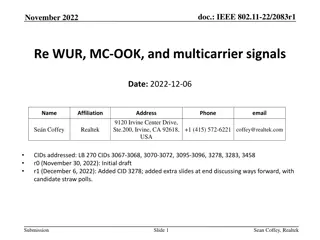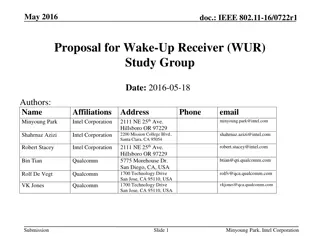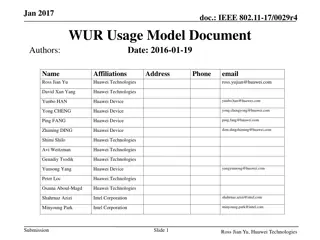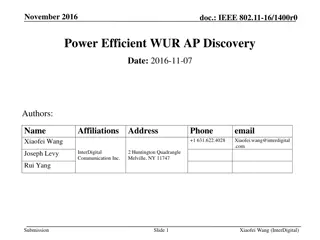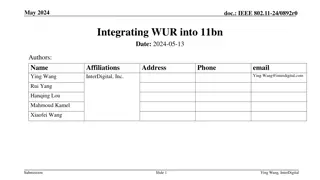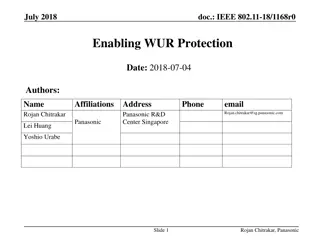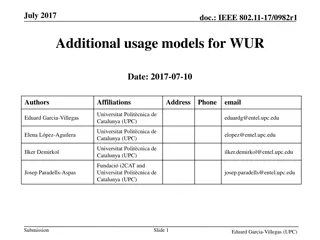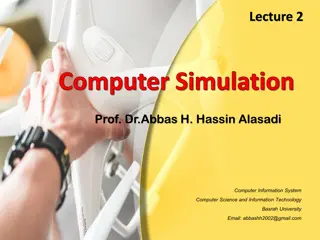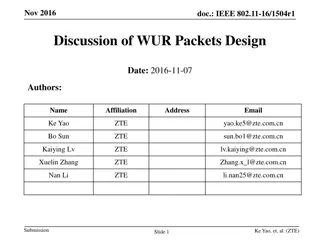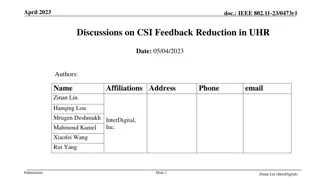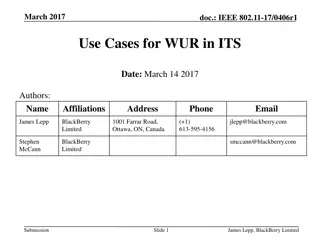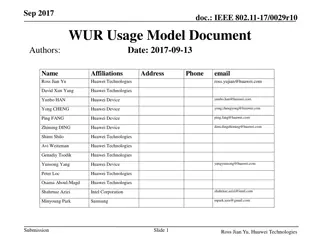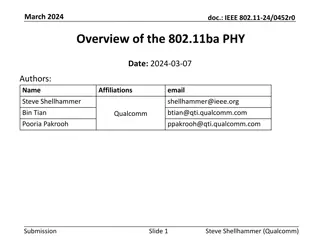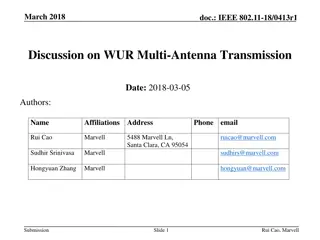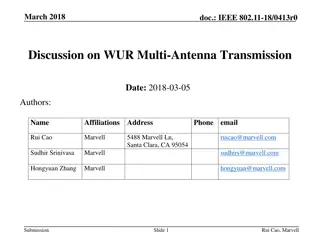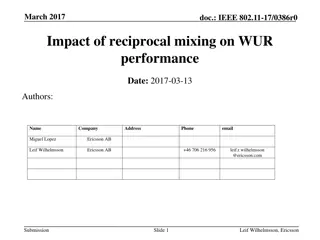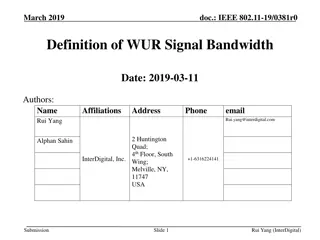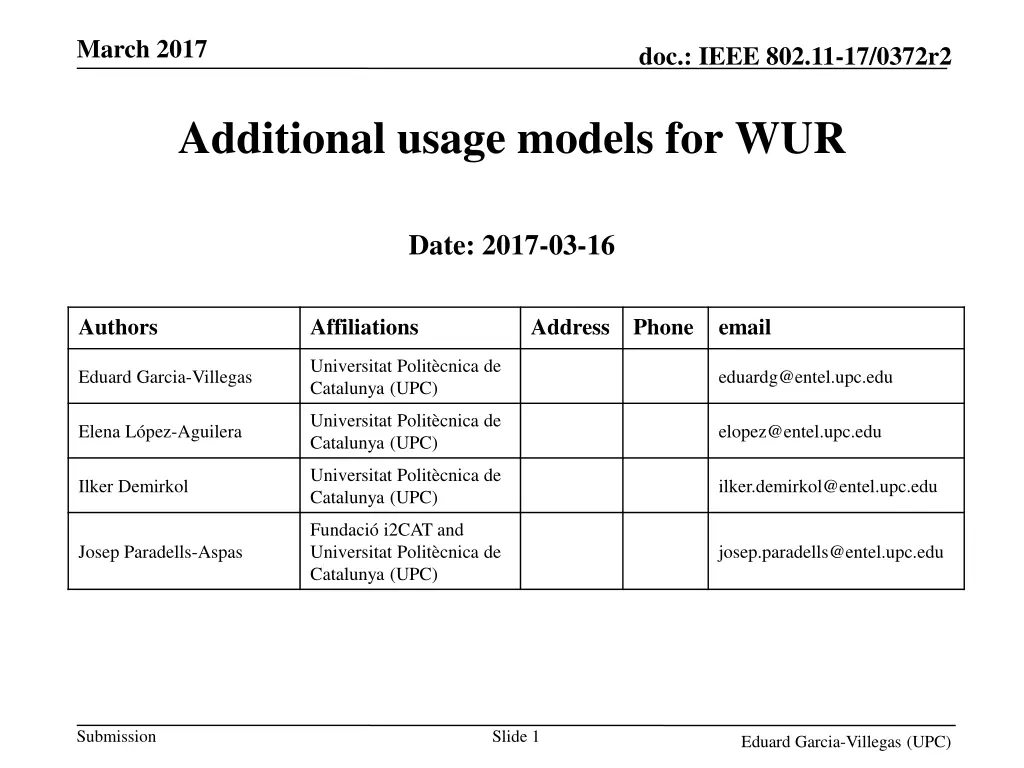
New Usage Models for Wireless Usage Reduction in IEEE 802.11 Standards
Explore additional usage models for Wireless Usage Reduction in IEEE 802.11 standards, including features like Put to Sleep packets, Wake-up AP, WUP Forwarding, Out-of-band Signaling, and Beyond IEEE 802.11. Learn how these models can improve energy efficiency, reduce interference, and enhance security in various environments.
Download Presentation

Please find below an Image/Link to download the presentation.
The content on the website is provided AS IS for your information and personal use only. It may not be sold, licensed, or shared on other websites without obtaining consent from the author. If you encounter any issues during the download, it is possible that the publisher has removed the file from their server.
You are allowed to download the files provided on this website for personal or commercial use, subject to the condition that they are used lawfully. All files are the property of their respective owners.
The content on the website is provided AS IS for your information and personal use only. It may not be sold, licensed, or shared on other websites without obtaining consent from the author.
E N D
Presentation Transcript
March 2017 doc.: IEEE 802.11-17/0372r2 Additional usage models for WUR Date: 2017-03-16 Authors Affiliations Address Phone email Universitat Polit cnica de Catalunya (UPC) Eduard Garcia-Villegas eduardg@entel.upc.edu Universitat Polit cnica de Catalunya (UPC) Elena L pez-Aguilera elopez@entel.upc.edu Universitat Polit cnica de Catalunya (UPC) Ilker Demirkol ilker.demirkol@entel.upc.edu Fundaci i2CAT and Universitat Polit cnica de Catalunya (UPC) Josep Paradells-Aspas josep.paradells@entel.upc.edu Submission Slide 1 Eduard Garcia-Villegas (UPC)
March 2017 doc.: IEEE 802.11-17/0372r2 Background Document 11-17/0029r4 (approved draft TGba Usage Models document) lists several usage models: 1. Smart Home 2. Warehouse 3. Outdoor Cattle Farms 4. Sensor Network Synchronized Wake Up 5. Wearable Devices Unsynchronized Wake Up 6. Wearable Devices Reconnection 7. Moving Goods Tracking Wake Up The present document is intended to extend that list with new ideas for new use cases. Submission Slide 2 Eduard Garcia-Villegas (UPC)
March 2017 doc.: IEEE 802.11-17/0372r2 Terminology from 11-17/0029r4: Usage Model A usage model is the combination of all the things below; not to be confused with a use case which is the specific set of steps to accomplish a particular task. Application A source and/or sink of wireless data that relates to a particular type of user activity. Examples are streaming video and VoIP. Environment The type of place in which the network of the use case is deployed, such as home, outdoor, hot spot, enterprise, metropolitan area, etc. Traffic Conditions General background traffic or interference that is expected while the use case steps are occurring. Overlapping BSSs, existing video streams, and interference from cordless phones are all examples of traffic conditions. Use Case A use case is task oriented. It describes the specific step-by-step actions performed by a user or device. One use case example is a user starting and stopping a video stream. Submission Slide 3 Eduard Garcia-Villegas (UPC)
March 2017 doc.: IEEE 802.11-17/0372r2 List of new Usage Models proposed Model # Usage Model 8 Put to Sleep packet 9 Wake-up AP 10 WUP Forwarding 11 Out-of-band Signaling 12 Beyond IEEE 802.11 Submission Slide 4 Eduard Garcia-Villegas (UPC)
March 2017 doc.: IEEE 802.11-17/0372r2 Usage Model 8: Put to sleep packet Use case 1. Upon user s request (or pre-configured automatic process) , a TGba STA sends Sleep Packet to one or multiple WUR- enabled devices. 2. Recipient/s of the Sleep Packet react by entering sleep mode to save energy/reduce interference/improve security/privacy. Sleep Packet may include configuration parameters (e.g. next wake-up time). Sleep Packets are just like WUPs (only differ in given flag(s)/header fields(s)) Requirements The SP transmission should enable coexistence with legacy IEEE 802.11 devices operating in the same band. SP transmission should be secured to prevent DoS. Targeted WUR-enabled devices have unique identifiers Support of different types of messages (e.g. WUP and SP). Environment Smart home/office (cf. usage model 1), warehouse (cf. usage model 2 and 7) or outdoor sensor deployment (cf. usage model 3) where (one or several) WUR-enabled devices do not go to sleep automatically or are executing (irrelevant) tasks preventing them to move to sleep. Applications Force energy-saving state on battery- driven things equipped with a compatible WUR. Remotely turn off the AP (or any other WUR-equipped STA) for energy savings, reduced interference, increased security and privacy. Traffic Conditions Interference with wake up packet transmission. Interference with neighboring legacy 802.11 transmissions in dense environments. Submission Slide 5 Eduard Garcia-Villegas (UPC)
March 2017 doc.: IEEE 802.11-17/0372r2 Usage Model 9: Wake up AP Use case 1.After TBD time of inactivity (or after Sleep Packet) , AP1 is put to sleep in order to save energy, to reduce interference with neighboring WLANs (no beacons, no probe responses, etc.) andor to improve security (turning off Wi-Fi reduces the chances of an intruder to access the network). 2.When user of STA1 requires network services, STA1 sends WUP to AP1. WUP may include initial configuration parameters (e.g. channel, bandwidth, power level, etc.) for the AP or AP discovery-related information. 3.Once AP1 is up, regular IEEE 802.11 transmission is established used between AP1 and STA1 (and other STAs). Requirements The WUP transmission should enable coexistence with legacy IEEE 802.11 devices operating in the same band. WUR-enabled AP WUR device has a unique identifier Optionally, WUP carries control information (e.g. initial config. parameters). Environment Domestic and small-office/home-office (SOHO) IEEE 802.11 deployments where network is in use only during office hours (or morning/evening hours in the case of domestic users). Applications Wake-up of IEEE 802.11 APs for energy savings, reduced interference, increased security and privacy. Traffic Conditions Interference with WUP/Sleep Packet SP transmission. Interference with neighboring legacy 802.11 transmissions in dense environments. zZzZz Submission Slide 6 Eduard Garcia-Villegas (UPC)
March 2017 Usage Model 10:Wake-Up (or Sleep) Packet Forwarding Environment IEEE 802.11-based wireless mesh network where multi-hop communication is required (e.g. infrastructure-less sensor network, distributed wireless backbone). AP-run BSS in SOHO environments where direct communication of WUP/SP may not be possible (only AP reaches all STAs). Applications Energy savings in multi-hop wireless mesh networks with on-demand routing/forwarding (data paths are created upon request) where inactive routers remain in sleep mode when not needed. Two-hop WUP/SP transmission in AP-based BSS. Traffic Conditions Interference with WUP/SP transmission. Interference with neighboring legacy 802.11 transmissions in dense environments. destination node s IP/MAC, etc.). STAs capable of transmitting and receiving WUPs. doc.: IEEE 802.11-17/0372r2 Use case 1 (multihop mesh) 1. After TBD time of inactivity (or after Sleep Packet), mesh routers are put to sleep in order to save energy and to improve security (turning off Wi-Fi reduces the chances of an intruder to access the network). 2. Upon activation of a new data flow, the multi-hop path is created on-demand according to source routing or reactive routing approach (e.g. AODV, IEEE 802.11s s HWMP). 1. Sleeping nodes along such path must be woken-up by forwarding WUP 3. Once all mesh nodes in the new path are awake, regular IEEE 802.11 is used to transport the data flow. Requirements The WUP transmission should enable coexistence with legacy IEEE 802.11 devices operating in the same band. WUR-enabled STAs have unique identifiers Optionally, WUP carries control information (e.g. freq. channel, Submission Slide 7 Eduard Garcia-Villegas (UPC)
March 2017 Usage Model 10:Wake-Up (or Sleep) Packet Forwarding doc.: IEEE 802.11-17/0372r2 Use case 1 (multihop mesh) 1. After TBD time of inactivity (or after Sleep Packet), mesh routers are put to sleep in order to save energy and to improve security (turning off Wi-Fi reduces the chances of an intruder to access the network). 2. Upon activation of a new data flow, the multi-hop path is created on-demand according to source routing or reactive routing approach (e.g. AODV, IEEE 802.11s s HWMP). Sleeping nodes along such path must be woken-up by forwarding WUP 3. Once all mesh nodes in the new path are awake, regular IEEE 802.11 is used to transport the data flow. Active node Sleeping node WUP transmission Simplified example: paths are pre- configured (i.e. no discovery phase) Legacy IEEE 802.11 Submission Slide 8 Eduard Garcia-Villegas (UPC)
March 2017 Usage Model 10:Wake-Up (or Sleep) Packet Forwarding doc.: IEEE 802.11-17/0372r2 Use case 2 (two-hop WUP/SP) 1. STA1 associated to AP1 wants to wake-up (or put to sleep) a WUR-compatible device, which is not necessarily within direct reach. 2. STA1 sends WUP/SP to a given (multicast/unicast) address. 3. The AP, upon detecting WUP/SP from associated STA and with destination different from the AP s address, retransmits the WUP/SP, thus extending the reach of the original packet. zZzZz Submission Slide 9 Eduard Garcia-Villegas (UPC)
March 2017 doc.: IEEE 802.11-17/0372r2 Usage Model 11: out of band signaling Environment Enterprise-level WLAN, composed of multiple APs, where neighboring APs use non-overlapping channels. APs may also be anchors of a multilateration positioning system (e.g. IEEE 802.11az?) Applications Transmit out-of band signaling information among APs/STAs through secondary radio to, e.g.: Provide initial configuration for primary radio (channel number, bandwidth, ESSID, etc.) Neighbor/Service discovery Transmit synchronization beacons [3] (e.g. for anchors in time measurement-based positioning). Traffic Conditions Interference with wake up packet transmission. Interference with neighboring legacy 802.11 transmissions in dense environments. Use case 1. AP1 is serving STAs on channel x and AP2 on channel y. Channel x and y do not overlap. 2. Both AP1 and AP2 use their MR to send Beacon messages decodable by TGba-compatible WUR at precise intervals. Beacon may include information on the transmitting AP (e.g. channel of MR, bandwidth, power level, etc.). 3. AP1 and AP2 become aware of each other without switching their MR s channels. Optionally, APs use those beacons to synchronize their clocks Requirements The WUP transmission should enable coexistence with legacy IEEE 802.11 devices operating in the same band. WUP (or beacon) carries control information (e.g. initial config. parameters). WUR is capable of receiving transmissions in any IEEE 802.11 channel (e.g. through envelope detector over whole ISM band) Ch.1 @2.4GHz Ch.6 Submission Slide 10 Eduard Garcia-Villegas (UPC)
March 2017 doc.: IEEE 802.11-17/0372r2 Usage Model 12: beyond IEEE 802.11 Traffic Conditions Interference with wake up packet transmission. Interference with neighboring legacy 802.11 transmissions in dense environments. Environment Smart home/office (cf. usage model 1), warehouse (cf. usage model 2 and 7) or outdoor sensor deployment (cf. usage model 3) where a collection of sensors/actuators and other things are not necessarily Wi-Fi compatible but are equipped with low-power WUR. Applications Use Wi-Fi compatible device (e.g. tablet, smartphone, smartwatch, etc.) to remotely control (e.g. switch on/off) sensors/actuators that are not necessarily Wi-Fi compatible. Transmit simple messages (WUP, initial configuration, discovery, etc.) to wireless devices with non-compatible primary radios (but with compatible TGba WUR). Requirements The WUP transmission should enable coexistence with legacy IEEE 802.11 devices operating in the same band. WUR-enabled devices have unique identifiers. Low-power recipients of WUP are equipped with TGba compatible WUR, but do not necessarily have an IEEE 802.11 primary radio (nor any other primary radio whatsoever). Submission Slide 11 Eduard Garcia-Villegas (UPC)
March 2017 doc.: IEEE 802.11-17/0372r2 Usage Model 12: beyond 802.11 Use case 2 (different primary radios) 1. STA with IEEE 802.11 or IEEE 802.15.4 (or other) primary radio sends WUP/SP to wireless device with non- compatible primary radio Use case 1 ( things ) 1. STA sends WUP/SP to actuator (e.g. garage door opener, window blinds, thermostat, etc.) Optionally, the WUP carries control information (e.g. new temperature for thermostat, open/close command to door opener, etc.). 2. Recipient of the WUP reacts accordingly, not being required to provide any feedback message to the originator of the WUP. 2. Recipient of the WUP, equipped with TGba WUR reacts accordingly, not being required to provide any feedback message to the originator of the WUP. Out of the scope of TGba IEEE 802.11 IEEE 802.15.4 TGba-compatible Submission Slide 12 Eduard Garcia-Villegas (UPC)
March 2017 doc.: IEEE 802.11-17/0372r2 Summary We provide several new usage models following the format of 11-17/0029r4. The goal of the usage models presented is to make the most of a (low-power) secondary radio capable of receiving messages from IEEE 802.11-compatible devices. Intention is to include those new usage models to the WUR Usage Model Document. Submission Slide 13 Eduard Garcia-Villegas (UPC)
March 2017 doc.: IEEE 802.11-17/0372r2 References 1. 2. 3. 11-17/0029r4, WUR Usage Model Document 11-17/0065r0, Usage Model for Power Saving AP 11-17/0343r0, WUR Beacon Submission Slide 14 Eduard Garcia-Villegas (UPC)
March 2017 doc.: IEEE 802.11-17/0372r2 Straw Poll 1 Would you add usage model 8 of this document to TGba s Usage Model Document in its current form? Yes No Abstain Submission Slide 15 Eduard Garcia-Villegas (UPC)
March 2017 doc.: IEEE 802.11-17/0372r2 Straw Poll 2 Would you add usage model 9 of this document to TGba s Usage Model Document in its current form? Yes No Abstain Submission Slide 16 Eduard Garcia-Villegas (UPC)
March 2017 doc.: IEEE 802.11-17/0372r2 Straw Poll 3 Would you add usage model 10 of this document to TGba s Usage Model Document in its current form? Yes No Abstain Submission Slide 17 Eduard Garcia-Villegas (UPC)
March 2017 doc.: IEEE 802.11-17/0372r2 Motion Do you agree to add Usage Model 9 (slide #6) from this presentation to TGba s Usage Models Document (11- 17/0029r4)? Mover: Ross Jian Yu Seconder: Abstain Yes No Submission Slide 18 Eduard Garcia-Villegas (UPC)



